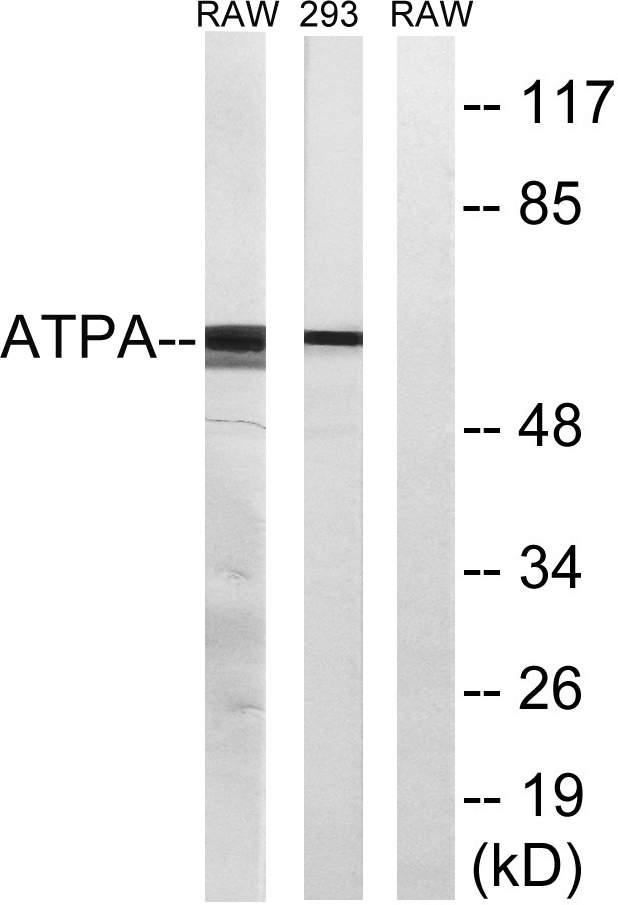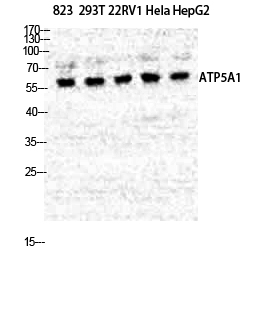产品名称
ATP5A Rabbit Polyclonal Antibody
别名
ATP5A1; ATP5A; ATP5AL2; ATPM; ATP synthase subunit alpha; mitochondrial
蛋白名称
ATP synthase subunit alpha mitochondrial
存储缓冲液
Liquid in PBS containing 50% glycerol, 0.5% BSA and 0.02% New type preservative N.
Human Gene Link
http://www.ncbi.nlm.nih.gov/sites/entrez?db=gene&term=498
Human Swissprot No.
P25705
Human Swissprot Link
http://www.uniprot.org/uniprotkb/P25705/entry
Mouse Gene Link
http://www.ncbi.nlm.nih.gov/sites/entrez?db=gene&term=11946
Mouse Swissprot No.
Q03265
Mouse Swissprot Link
http://www.uniprot.org/uniprot/Q03265
Rat Gene Link
http://www.ncbi.nlm.nih.gov/sites/entrez?db=gene&term=65262
Rat Swissprot Link
http://www.uniprot.org/uniprot/P15999
免疫原
The antiserum was produced against synthesized peptide derived from human ATP5A1. AA range:201-250
特异性
ATP5A Polyclonal Antibody detects endogenous levels of ATP5A protein.
稀释度
WB 1:500 - 1:2000. IHC 1:100 - 1:300. ELISA: 1:40000.. IF 1:50-200
宿主
Polyclonal, Rabbit,IgG
背景介绍
This gene encodes a subunit of mitochondrial ATP synthase. Mitochondrial ATP synthase catalyzes ATP synthesis, using an electrochemical gradient of protons across the inner membrane during oxidative phosphorylation. ATP synthase is composed of two linked multi-subunit complexes: the soluble catalytic core, F1, and the membrane-spanning component, Fo, comprising the proton channel. The catalytic portion of mitochondrial ATP synthase consists of 5 different subunits (alpha, beta, gamma, delta, and epsilon) assembled with a stoichiometry of 3 alpha, 3 beta, and a single representative of the other 3. The proton channel consists of three main subunits (a, b, c). This gene encodes the alpha subunit of the catalytic core. Alternatively spliced transcript variants encoding the different isoforms have been identified. Pseudogenes of thi
组织表达
Fetal lung, heart, liver, gut and kidney. Expressed at higher levels in the fetal brain, retina and spinal cord.
细胞定位
Mitochondrion . Mitochondrion inner membrane ; Peripheral membrane protein ; Matrix side . Cell membrane ; Peripheral membrane protein ; Extracellular side . Colocalizes with HRG on the cell surface of T-cells (PubMed:19285951). .
信号通路
Oxidative phosphorylation;Alzheimer's disease;Parkinson's disease;Huntington's disease;
功能
function:Mitochondrial membrane ATP synthase (F(1)F(0) ATP synthase or Complex V) produces ATP from ADP in the presence of a proton gradient across the membrane which is generated by electron transport complexes of the respiratory chain. F-type ATPases consist of two structural domains, F(1) - containing the extramembraneous catalytic core, and F(0) - containing the membrane proton channel, linked together by a central stalk and a peripheral stalk. During catalysis, ATP synthesis in the catalytic domain of F(1) is coupled via a rotary mechanism of the central stalk subunits to proton translocation. Subunits alpha and beta form the catalytic core in F(1). Rotation of the central stalk against the surrounding alpha(3)beta(3) subunits leads to hydrolysis of ATP in three separate catalytic sites on the beta subunits. Subunit alpha does not bear the catalytic high-affinity ATP-binding sites.,PTM:The N-terminus is blocked.,similarity:Belongs to the ATPase alpha/beta chains family.,subcellular location:Peripheral membrane protein.,subunit:F-type ATPases have 2 components, CF(1) - the catalytic core - and CF(0) - the membrane proton channel. CF(1) has five subunits: alpha(3), beta(3), gamma(1), delta(1), epsilon(1). CF(0) has three main subunits: a, b and c. Interacts with ATPAF2.,tissue specificity:Fetal lung, heart, liver, gut and kidney. Expressed at higher levels in the fetal brain, retina and spinal cord.,
纯化
The antibody was affinity-purified from rabbit antiserum by affinity-chromatography using epitope-specific immunogen.



.jpg)
